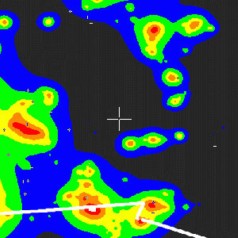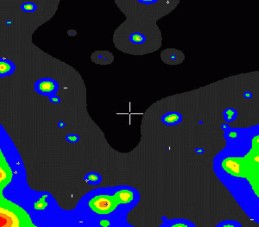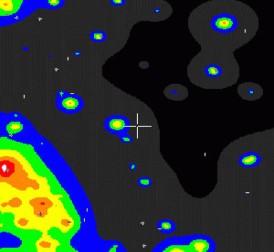Observing Sites |
Far Point Station - East Riverside County, CA |
I set up at a few different spots in the huge Palen-McCoy wilderness, and all of
them are fairly dark. It is on the southeast corner of Joshua Tree National
Park. Just over the mountains to the east, General George Patton
had a large training area for his tank command. I think this is the darkest
area near the major population centers of Socal. On a typical night
naked eye limiting magnitude at zenith is 7.4 and seeing is a Pickering 6 or better.
There is a 15 degree light dome from Palm Springs/Palm Desert to the
west, and a 10 degree light dome from El Centro to the south. If the air
is moist or dusty you will see a small light dome from Las Vegas to the northeast.
Blythe and a prison cause a 5 degree dome to the east/southeast.
This is a prime winter site as daytime temps are in the 70's to 80's and night
temps are around 40 degrees. Summers however can be brutally hot with
daytime temps ranging from 100 to 115 degrees, the nights are a comfortable 80
degrees. However during the summer the seeing suffers from heat radiating
from the ground most of the night. All of these spots require a high clearance
4X4 for access and dont forget the shovel if you get stuck.. This
is my favorite spot for a quick observing fix, but watch out for nocturnal sidewinder
rattlesnakes that can park themselves under your big dob. This past
spring one crawled out from under my scope, coiled up and started rattling away
within striking distance of my legs. Yikes! |
Mesquite Springs Camp Death Valley, CA |
Mesquite Springs camp is located at the north end of Death Valley at 1800 ft. and
sports some of the darkest skies I have ever seen. It is a fairly large
campground with running water, toilets and picnic tables. There are no electrical
hookups and the fee is $10 per night. You want to be self sufficient
when you come to this spot as amenities are few and far. Nearby Scotty's
Castle has gas, water, ice and a cafe but otherwise the nearest place to resupply
is Stovepipe Wells, 30 miles away, or Furnace Creek over 50 miles away.
During the week you will most likely be alone in the camp with only the
rodents, coyotes, and snakes for company. On the weekend there may be a couple
of other folks around but their lights will probably be out shortly after
dark. Winter weekends can be more crowded as will holidays. Naked
eye limiting magnitude is typically 8.0 at zenith and the glow of the Milky Way
will cast your shadow on the ground and other light colored objects. If
clouds move through during your observing session they will look like black holes
in the sky as there is no light to reflect off of them. The only light
pollution around is a small 5 degree dome from Las Vegas which is insignificant.
The zodiacal light is very bright and the Gegenschien is easily visible.
Its amazing what a small scope will show in these skies. If you
want to do your Herschel 400 in a 4 inch scope this is the place to do it.
Likewise, the views of the showpieces in a big scope will knock you right off
the ladder. As typical for a low desert site the best time of year
is winter. Summer temps will be a scorching 110 degress during the day with
little relief as the night temps hover in the mid 80's.
|
A good way to kill time during the day is to take in the numerous sites in the park.
The sunsets are not to be missed as the shadows and alpenglow on the
mountains is spectacular. This has become favorite spot regardless of the
many rules that come with camping in a National Park. |
Grandview Camp, White Mountains Inyo National Forest, CA |
Grandview campground is located at 8600 ft. in the White Mountains just east of the
High Sierra. The skies here are as dark as Death Valley with NELM at zenith
around mag 8.0. There is a small 8 degree light dome to the west from
the town of Bishop 4000 ft. below. The White Mountains see very little
moisture being in the rainshadow of the higher Sierras so the site is quite dusty
and dew is definately not a problem. Unfortunately, seeing can
often be poor here as it is downwind from the 14,000 ft. Sierra Crest. |
The campground is primitive with pit toilets, no running water or electricity, but
the bonus is that you camp free of charge. One downside is that there are
very few good spots to set up due to the large trees. At no campsite will
you have a 360 degree unobstructed horizon. At best, your view will only
be obstructed either to the north or the south depending on which side of the
camp you set up. However, there are many campsites where trees will block
most of the sky. To make matters worse the place is a dust bowl but there
are few cars driving through to kick up the fine dust. The camp is relatively
deserted but nonetheless it is well known to So Cal stargazers so dont
be surprised to see other scopes set up. The prime time for this spot is
during the summer and it is a great escape from the heat of the desert.
Summer daytime temps range from the 70's to 80's with nights cooling to the 30's
or 40's. When I was there this June a cold front had passed through resulting
in nightime temps in the low 20's so bring some warm clothing and a small
stove to make hot tea or coffee. There are plenty of spots to hike, mountain
bike, or sight see during the day if you cant sleep. For replentishing
supplies, the town of Big Pine is only 15 miles down the hill and has a market,
gas and convenience/hardware store. For better amenities the town of
Bishop is only 17 miles further away with a large grocery store and a Wal-Mart
in addition to many other stores and restaurants. |



Tierra Del Sol, CA [San Diego Astronomy Association Site] |